
This site is a digital adaptation of the rulebook for Vampire: The Masquerade - Heritage, and contains content from the rulebook with extra content and features. It is designed as a companion to the rulebook for quick and easy reference, not a replacement.
Additional information to help your group find their way on their first few plays is provided in the form of guidance paragraphs.
In the printed rulebook, the torpor token shows the incorrect icon.
In the printed rulebook, the setup for the Sabbat Wars battleground incorrectly identifies the Camarilla and Sabbat tokens. The A and B icons should be switched.
Two battlegrounds show incorrect roman numerals. The numerals on battleground E should be III; the numerals on battleground G should be V-VII.

Our story begins in a dark reflection of medieval Europe. Behind the plots of mortal kings and queens, true monsters rule from the shadows, bending the flow of history to their own obscure purposes. You are one of those monsters.
Take control of vampiric conspiracies, shape bloodlines and form coteries to dominate the shifting battlegrounds of the night. Will you ultimately prevail in this struggle of ages? Or will ancient rivals snatch victory from your fangs at the end of the millennium?
Carpe Noctem.
Vampire: The Masquerade – Heritage is a competitive legacy game. This means you play repeatedly, each time with new pieces, cards, and stickers depending on player choices. Each chapter is self-contained and has a specific winner, while also being part of the ongoing chronicle.
The lore of Vampire: The Masquerade spans millennia of alternative history, clan politics, and bloody feuds. Throughout the chronicle, you will have the opportunity to delve deep into that World of Darkness, but also shape it (and the game itself) in a myriad of ways.
Players already familiar with the World of Darkness will notice some quirks in the way terms are used. “How can a Toreador be embraced into my Nosferatu bloodline? Since when is Talley the ‘clan leader’ of the Lasombra? Why is this powerful ancilla also a fledgling? Inconceivable!”
A certain level of abstraction is necessary in any game, and we hope such moments allow you to weave your own tales. That Toreador might be a trusted advisor or an enemy blackmailed into servitude. That ancilla might be temporarily weakened from being “convinced” to join you!
Vampire: The Masquerade – Heritage is ultimately a game about ancient monsters scheming in the shadows. It’s not possible to consider all the outcomes, and sometimes the best-laid plans are undone by a simple stake through the heart. You can’t control everything … but you can always vow revenge!

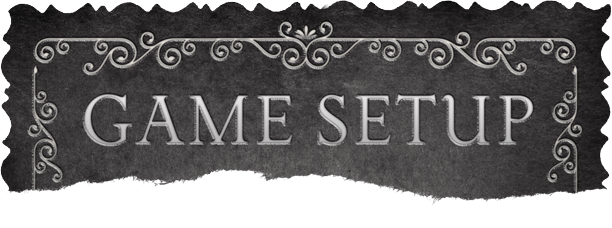
The rules below are used for a basic (non-chronicle) game. For chronicle play, modify the rules with the indicated alternatives.
1 the main board in the middle of the table. and draw 0-5 basic missions onto the main board (this number is player preference in a basic game - use fewer missions for a simpler game).
Chronicle: Rather than using basic missions, 1 chapter overview and 5 chronicle missions from the chronicle deck.
2 Shuffle and 5 characters onto the main board to form the queue. The remaining characters make up the character deck.
3 the round marker on the main board in the 1st space.
4 3 battleground boards in the middle of the table , along with their associated and . For the first chapter these are: Of Clans High and Low, The War of the Princes, and The Beast Within.
5 Assign the first player marker randomly.
Chronicle: In the initial chapter, assign the first player marker to the oldest player. In all following chapters, assign it to the vanquished (last place) player from the previous chapter.
6 Each player sets up their bloodline:
a clan, along with player aid, clan schemes, and clan tokens. a clan leader by flipping the card face-up and placing it at the top of your play space.
Chronicle: In the initial chapter, the youngest player selects first, while the oldest selects last. In all following chapters, select in reverse order of the previous chapter’s outcome (i.e. the victor of the previous chapter selects last).
7 3 power and 3 clan boons on your clan leader and the clan marker close by.
8 the clan morality token on its associated battleground (The Beast Within / The Rise of Humanity).
9 the clan schemes listed on your clan leader into hand, shuffling the rest together to form a deck.
Chronicle: All players with obligations the indicated effects after setting up their bloodline
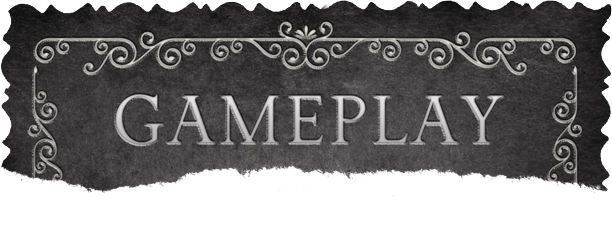
Players recruit characters into their vampiric bloodline to influence the outcome of 3 contested battlegrounds. After the final round, players score victory points according to the outcome of each battleground and the vampires in their bloodline.
The player with the most victory points wins.
On their turn, a player carries out the following phases in any order:
a character from the queue to add to your bloodline. This character is then , modifying each battleground according to their attributes.
and
and exhaust the coterie leader to carry out the effects of a scheme – either or .
Turn order moves clockwise around the table, and the round is over when all players have finished their turn.
the relevant battleground (The Beast Within / Rise of Humanity) to assign the first player marker. the round marker down, and begin the next round.
Chronicle: Once per turn, a player may discard an asset ( / / / ) to carry out the effect indicated on the player aid card. A discarded asset cannot be used again for the rest of the chronicle.
 ) unless you are currently playing .
) unless you are currently playing .Chronicle: Once per game, a player may a retained character from their haven, rather than from the queue. Follow all the regular rules for the recruit phase.
The recruit phase usually represents a being embraced into your bloodline. However, it can also represent your bloodline adopting as advisors, mercenaries or servants. You can even recruit vampires from !
If the character deck is every completely discarded, immediately shuffle the discarded characters into a new deck. Use this new character deck as normal. If a player is using Embrace the Chaos (the Malkavian special ability) they continue seeking the declared attribute from the top of this deck as normal.
Vampires are always activated when recruited into a bloodline, but they can also be activated by particular schemes or abilities.
each battleground according to the activating vampire’s . Check the associated rules, and fully resolve each battleground before moving to the next. You cannot skip modifying a battleground when a vampire is activated; each effect must be carried out.
Powerful vampires (called ) have special abilities that are triggered when recruited into a bloodline, but they can also be triggered by particular schemes.
the full effect of each of the triggered vampire’s abilities before moving to the next (top to bottom). You cannot skip any ability; all effects must be carried out if a valid target is in play.
An exhausted vampire cannot be selected as the coterie leader when playing a scheme.
New clan schemes are only drawn as a result of
 /
/
 battlegrounds, or particular schemes and abilities. It is possible to run out of clan schemes during a game. When a player must draw a clan scheme but has none available, nothing happens.
battlegrounds, or particular schemes and abilities. It is possible to run out of clan schemes during a game. When a player must draw a clan scheme but has none available, nothing happens.
Tokens are always associated with a specific vampire and are directly on the card.
If your would receive infamy, to one of their childer instead. If your clan leader would be placed into torpor, one of their childer instead. In both cases the selected childe must not be in torpor. If the clan leader has no available childer, nothing happens.

Each player recruits the same number of characters each game, one per round. The number of rounds is determined by the player count, as indicated on the main board:
The game ends as soon as the final round is finished.
Number of players | 2 | 3 | 4 |
Rounds | 10 | 9 | 8 |
At the end of the game, each mission is by the player with the most of the indicated in their bloodline. Vampires in torpor are not part of the player's bloodline, and do not count towards claiming missions. Ties are broken by counting each 's relevant attribute twice (a warlike clan leader adds two warlike symbols, rather than one). Consult the primogen if players are still tied.
Tally each player’s victory points according to the outcome of each battleground and the vampires in their bloodline, as well as their...

power (+1 VP)

boons (+1 VP)

infamy (-1 VP)

torpor (always 0 VP)
Vampires in torpor are not considered part of the bloodline, and do not affect VP in any way (including their power, infamy, and boons).
Mark these victory points using your clan markers and the scoreboard on the back of the rulebook.
The player with the most victory points is the winner.
Ties are broken in favor of the player who claimed fewer missions.
Chronicle: Claimed missions do not earn power, but impact the aftermath phase.
There are three moments during the chronicle when ties may need to be resolved: determining which player claims a mission, which player wins a chapter, and which player dominates an era. Each has their own initial tie-breaker, but if this fails there is a final step to determine the outcome.
Every tied player declares a different archetype. Shuffle the character deck and draw from it until the declared is revealed. That player wins the tie.
See clan section for following abilities: Black Market, Craft Monstrosity, Declare Enemy, Edict, Embrace the Chaos, Invitation, Kiss the Ring, Pack, Usurp
corresponding battleground. When , modify all three battlegrounds.
Any with one or more special abilities.
The activating player chooses any other player and applies the indicated effect.
power/infamy from the supply on the indicated vampire.
Colors indicating a character’s qualities in three categories: class
 /
/
 , temperament
, temperament
 /
/
 , and geography
, and geography
 /
/
 /
/
 /
/
 . Also, the symbol indicating a character’s archetype: warlike
. Also, the symbol indicating a character’s archetype: warlike
 , scholarly
, scholarly
 , clandestine
, clandestine
 or wealthy
or wealthy
 .
.
Each player’s collection of recruited vampires, branching down from (and including) their clan leader. This excludes vampires in torpor unless explicitly stated otherwise.
Apart from the clan leader, every vampire in a player’s bloodline is the childe of their sire - the vampire directly above them. It is possible for a vampire to be both a childe and a sire.
Boons can be used to help satisfy the archetype requirements of any scheme.
When playing a scheme, any boon from your bloodline (including those from other clans) to any vampire in an opponent’s bloodline. Add that vampire’s archetype to the coterie being formed. For game effects, the coterie members still consist only of the coterie leader and their direct childer. Each clan boon in a player’s bloodline is worth +1 victory points at the end of the game.
Vampire at the top of each player’s bloodline. If your clan leader would receive infamy, it to one of their childer instead. If your clan leader would be placed into torpor, one of their childer instead. In both cases the selected childe must not be in torpor. If the clan leader has no available childer, nothing happens.
The vampire selected to a clan or battleground scheme. effects always refer to the coterie leader.
The coterie leader plus all their . This means the maximum coterie size is four (the coterie leader and up to three direct childer), and makes the very important. Unless clan boons have been used, these vampires must meet the scheme’s archetype requirements.
An exhausted vampire cannot be selected as the coterie leader when playing a scheme. However, they still any coterie formed by their sire and clan boons from other players as normal.
Any vampire in a player's bloodline with . It is possible for a vampire to be both a fledgling and an ancilla. However, a fledgling cannot be a sire.
Place the indicated power/infamy from the supply on the or the vampire their ability.
Characters in the left-most spaces of the queue to be recruited, as indicated on the main board. Each power in a player’s bloodline is worth +1 victory points at the end of the game.
Many aggressive schemes and abilities may only those vampires with infamy. Each infamy in a player’s bloodline is worth -1 victory points at the end of the game.
both exhaustion and torpor tokens from the selected vampire. Unlike other schemes and abilities, this effect may always be applied to vampires in torpor.
clan marker token on any unreserved character in the queue. This character cannot be recruited by any other player, but can be from the queue or usurped. Remove token at the beginning of your next turn.
Select any character(s) in the queue and in a discard pile. Then refresh the queue as normal.
If a vampire in your bloodline would be placed into torpor, you may by placing one of their childer instead. A vampire that is already in torpor cannot be sacrificed.
Every vampire in a player’s bloodline (including the clan leader) is a sire if they have a vampire directly beneath them (childe). It is possible for a vampire to be both a sire and a childe.
the indicated token(s) from the selected vampire to the coterie leader or the vampire triggering their ability.
A vampire in torpor is effectively removed from the player’s bloodline. They cannot:
Vampires in torpor are not included in the player’s bloodline when resolving game effects, or scoring victory points.
If a vampire in your bloodline would be placed into torpor, you may choose to sacrifice by placing one of their childer into torpor instead.
the full effect of each of the triggered vampire's abilities before moving to the next (top to bottom).

Vampire: The Masquerade – Heritage is designed to be played as a single, epic chronicle of 21 chapters. At the end of the final chapter, one player is crowned the overall winner.
To start a campaign, all players take part in a prologue: setting up their player sheet, haven, and first retainer. Then play through the first chapter, using the basic game rules in this booklet as well as the red chronicle additions.
The chronicle deck is central to this mode, and contains more than 700 years of vampiric and human history to be revealed from the front in a very specific order. You should never shuffle the chronicle deck. You should also avoid the temptation to peek ahead!
After each chapter, players make decisions and record results in the aftermath step. Every three chapters, the current era comes to an end while the next begins. This marks a turning point in history, exchanging a battleground for a new one and allowing the player who dominated that era to significantly impact the chronicle.
After the 7th era, follow the steps outlined in the Chronicle End section to conclude your campaign.
Chronicle: This prologue demonstrates how to use the game’s legacy elements, and should be completed prior to beginning your chronicle.
Our story begins in 14th-century Europe. The players are rival childer thrust into bitter conflict after slaying their powerful sire. Now the deed is done and the temporary truce is over …
The Prologue is a chance to establish your player character for the coming centuries! Are you a silver-tongued charlatan, or a solitary hermit alone in the wilderness? Maybe a ruthless assassin seeking vengeance? Choose dots that highlight the experiences and background of your character.
Traits score variable points at the end of the chronicle. However, their value hasn't yet been determined, so this is purely thematic at the beginning of the chronicle.
Your title is the first of many gathered through history. It could be the "fairy tale" told by mortals to scare their children, the secret name whispered by your enemies in halls of power, or the military rank earned in long-forgotten battles.
Select your first retainer and elevate them to :
You are ready to begin the first chapter. Setup and begin your first game using all the chronicle rules.
Finally, your retainer is the vampire you turned to at the beginning of this long feud between siblings. He could be a Ventrue priest, able to grow your influence from the puplit. Or perhaps a Nosferatu wretch using her shady network to uncover secrets.
The chronicle is based primarily for a single group of consistent players. However, it is possible for players to drop in and out. Each player carries out a prologue when they join, and gains 1 free dot in any section of their player sheet for each missed chapter.
Before starting the aftermath, it's fine to make space on the table for the legacy elements (chronicle booklets, player envelopes, character sheets etc.) by removing the battlegrounds and the mainboard. You should however leave the players' in place, since they will be needed throught this process. Remove any vampires in torpor. Then take out all cards from the chronicle deck until you reach the next chapter overview card.
An aftermath occurs after each chapter, recording the results and revealing new content for the rest of the chronicle. Carry out the following steps in order.
each player's name and the clan used in the indicated spaces of the chronicle booklet. This provides era points, and ultimately determines which player dominates the era.
Each provides different outcomes for the victor (first place) and vanquished (last place).
your new title in the space indicated on your player sheet. Each title is worth 1 point at the end of the chronicle.
Plotting unlocks clan schemes, making them playable for the rest of the chronicle. the indicated number of clan schemes from the research deck, adding them to the relevant clan deck. Players may only unlock clan schemes of the clan they played in this chapter.
Each mission is by the player with the most indicated in their bloodline. Flip the missions over and gain rewards as detailed in the Chronicle Missions section. All unlocked content can be found by drawing from the chronicle deck.
The winning player adds 1 random obligation to their haven. Each other player removes 1 random obligation from their haven. It is possible to accumulate several obligations by winning repeatedly.
Each player may an ability sticker on any in their bloodline or haven with a free ability slot. The player sheet determines which stickers may be selected, with more powerful abilities requiring higher attribute scores.
Each player may move any vampire from their bloodline into their haven (which excludes those in torpor). This character may then be recruited in the next chapter. Only one vampire may be retained in each haven. Vampires unlocked via missions may be retained instead.
New characters become available to recruit as time progresses. each card with the basic side visible, and add to the character deck.
Chronicle characters are always ancillae, and are by claiming corresponding missions. If the character does not show a clan affiliation, the claiming player the sticker of the clan just played. Then with either side visible. Chronicle characters may be retained or added immediately to the character deck.
Additional clan leaders are unlocked by claiming the corresponding mission. The claiming player the clan leader to their haven, and may use them instead when playing that clan. If the indicated clan schemes have not yet been unlocked, permanently them to the deck when needed.
The player who dominated the era one card, the indicated dots to the chronicle scoresheet (at the back of the chronicle booklet). This permanently alters the value of the traits on all player sheets, for the purposes of scoring at the end of the chronicle.
The indicates when one chapter is finished, and the next is about to begin.
Each presents a situation that demands a choice. The claiming player selects their response and 1 dot on their player sheet.
Each chronicle mission also provides one of three possible rewards:
For a more thematic experience, players should make their decision about how to resolve the mission without knowing the rewards (have another player read it to you). We recommend playing this way, but you can also play with full information for a more competitive experience.
Chronicle: Any time a player applies a clan sticker, they may instead apply a sticker. These characters are played as normal, but due to their weakened vampiric lineage do not belong to any clan, so always cost 3/1 power when in the left-most spaces of the queue. Thin Bloods may not be bonded (a powerful sticker ability).

any clan scheme from your discard pile into hand.
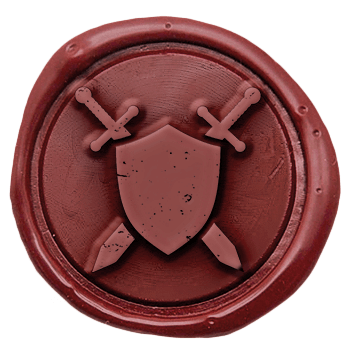
1-5 characters from the queue.

any vampire.

the abilities of any vampire in your bloodline.
Players shape their shared world with each successive era, bending history to favor their own traits – at the expense of their rivals.
Ending the seventh era means resolving a feud centuries in the making.

Each chapter, you will choose to control one of nine vampire clans, each with a unique mechanic unavailable to the others. Their relative strengths and weaknesses change throughout the chronicle, as new clan schemes are unlocked and specific characters are embraced.
The chart below indicates each clan’s complexity to play, the player count at which it tends to be strongest, and the archetype most comm only required by clan schemes.

BrujahThe Rabble
COMPLEXITY: Low
Best at: 2 players
Affinity:


GangrelThe ANIMALS
COMPLEXITY: Medium
Best at: 2-4 players
Affinity:


LasombraThe Shadows
COMPLEXITY: Low
Best at: 4 players
Affinity:


MalkavianVision & Madness
COMPLEXITY: Medium
Best at: 2-4 players
Affinity:


NosferatuThe Hidden
COMPLEXITY: Medium
Best at: 4 players
Affinity:


ToreadorThe Hedonists
COMPLEXITY: Low
Best at: 3-4 players
Affinity:


TremereThe Warlocks
COMPLEXITY: High
Best at: 4 players
Affinity:


TzimisceSovereign Fiends
COMPLEXITY: High
Best at: 2-4 players
Affinity:


VentrueThe Patricians
COMPLEXITY: Medium
Best at: 3-4 players
Affinity:

Each clan features a unique mechanic only found on their clan schemes. Special Clan Abilities are represented by a bolded keyword on the card. This bolded keyword signifies that the special ability is to be carried out.
Quick to anger and always passionate, the Brujah have been lofty philosophers and activists just as often as they have been unruly rebels. Their deep involvement and unbridled anger in the face of perceived injustice means they should not be antagonized.
The Brujah’s ability to declare enemies and make them suffer with follow-up schemes makes them intimidating foes. However, this propensity for direct conflict can be their downfall - punishing enemies is not always enough to improve their own position. More prudent Brujah can use the threat of violence to keep other clans out of their way, without ever needing to get their hands dirty.
this scheme to any vampire in any opponent's bloodline. That vampire is now an .
Enemies in torpor follow all the normal rules, and cannot be targeted by further schemes or abilities. When counting the number of enemies, those in torpor are not included.
The Gangrel are a clan of feral nomads. They hold closer ties to wild places than most kindred and always feel the animalistic aspect of their vampiric curse.
Their pack ability allows the Gangrel to trigger schemes for devastating effect in many different contexts. To form these large packs, they must focus on a single geographic attribute. This feral attachment to certain locations can make the Gangrel vulnerable to attentive opponents. For this reason, it can sometimes be wise to diversify into a second attribute.
All vampires in your bloodline that the 's
 /
/
 /
/
 /
/
 /
/ attribute.
attribute.
 vampires count as their own pack, and may not join those of other attributes.
vampires count as their own pack, and may not join those of other attributes.
Clan Lasombra are social Darwinists with a firm belief in their right to rule. These elegant and inhuman predators cannot be seen in mirrors, bodies of water or any reflective surface.
For maximum effect, the Lasombra need to make their ‘offers’ at just the right time. This ability to directly coerce concessions from opponents doesn’t win the Lasombra any friends. The Lasombra should therefore be careful to avoid uniting their opponents; one approach is returning clan boons (very occasionally) to the weakest player.
Each opponent may to your coterie leader, otherwise the applies to their .
The negative effect of Kiss the Ring applies only to opponents who do not give a clan boon.
Malkavians are the seers and oracles of the kindred. While their vampiric curse tends to give the power of vision and foresight, every last one is irredeemably insane.
By embracing the chaos, Malkavians completely bypass the queue, ensuring they can always find that crucial attribute. This ability becomes stronger as more ancillae populate the character deck. However, it can be a double-edged sword, as recruiting the wrong ancilla is sometimes catastrophic. Malkavians also lack the means to retaliate or recover from attacks, so should avoid attracting the ire of their opponents.
Declare an . from the deck until you find a character with this attribute - recruit them, discard the rest. Carry out before and instead of recruit phase.
All the usual recruiting rules apply when embracing the chaos. Remember to the new recruit and trigger their abilities.
It is never possible to recruit more than once per turn. If a player has already recruited, they cannot embrace the chaos (and vice versa).
Hideously deformed by their vampiric curse, Nosferatu are the masters of the underground. They tend to live in secret and trade information for survival.
Clan Nosferatu can manipulate infamy away from themselves and towards rivals. In addition, black market schemes provide a steady income of boons and direct benefits (by using it themselves). One potential danger is providing a new tool that may advantage their opponents more than themselves. For this reason, the Nosferatu should stir up trouble amongst the other players wherever possible - always ready to help clean up the mess.
face-up on table. Each round, 1 player may the effect by placing a boon on the scheme during their turn. these boons to the Nosferatu clan leader at end of round.
Black market schemes are not triggered when initially played. The Nosferatu player must move a boon to the black market in order to trigger its effect.
If a black market already has a boon, it may not be triggered again in this round.
Black market schemes remain in play, and there is no limit to the number that can be played.
A clan of artists and innovators, Toreador are the most beautiful, sensual, emotional and glamorous creatures of the night.They are responsible for the legends of vampires who seduce and entice their prey with raw sensuality.
The Toreador require a mastery of clan politics to unlock the full effect of their invitation schemes. However, they are also the most attuned to the mortal world, and therefore most adept at manipulating the queue. This becomes increasingly valuable as more powerful ancillae enter the chronicle, and it becomes possible to recruit any character in the deck. Toreador must remain subtle and non-threatening above all.
Choose any opponent. They may to also gain the effect. If so, your coterie leader 2
 .
.
The Toreador player may choose not to invite anyone.
Power gained from invitations is taken from the supply, not the invitee.
The Toreador player chooses the order in which invitation effects are triggered. This order should be determined before the invitee accepts.
When recruiting any character from the deck, all the normal recruiting rules apply, and no other character may be recruited this turn. Shuffle the character deck when finished.
The Tremere are known as a clan of warlocks and interlopers after being founded by mages who took their vampiric powers by force. They place a high value on hierarchy and secrecy, wielding powerful blood magic for their own ends.
With a number of aggressive schemes – as well as the ability to quickly adapt their bloodline – Clan Tremere excel at direct conflict. Because their schemes are fuelled by vampires in torpor, they tend to promote violence between all the players. However, an over-reliance on usurpation can make it difficult to plan for the end game, leaving many battlegrounds wasted.
any vampire in your bloodline (including those in torpor) with a character from the queue. all tokens except torpor to the new vampire.
When usurping, all tokens except torpor are moved to the new character. The original vampire is discarded from the bloodline.
Usurpation does not count as a recruit. Do not activate the new character or trigger their abilities.
Do not pay power when using usurpation to take characters from the two left-most spaces.
Clan Tzimisce are scholars and flesh-shapers who have gladly left the human condition behind. Now their focus is on transcending the limits of the vampiric state.
By crafting monstrosities, the Tzimisce are able to pursue strategies impossible for any other clan. These experiments can produce a huge variety of combined effects. However, this reliance on ancillae can place them at the mercy of the queue - and they are severely weakened at the beginning of the chronicle. One useful strategy is crafting monstrosities as a way of denying ancillae for opponents.
any from the queue, them beneath any vampire in your bloodline with only the ability visible. The vampire is now an ancilla with this ability.
Craft monstrosity does not count as a recruit. Do not activate or trigger the abilities of the selected ancilla.
All of the selected ancilla’s abilities will be added to the monstrosity in your bloodline. It is not possible to add just one or two.
There is for the number of ancillae that can be combined into a single monstrosity. Follow all the usual rules for triggering abilities – each occuring in order from top to bottom
Do not pay power when using craft monstrosity to take characters from the two left-most spaces.
The Ventrue wish to be seen as nobles, rulers and aristocrats. This show of honor and “noblesse oblige” may sometimes conceal their unrivaled desire to control and dominate – but it never truly diminishes.
With their edicts, Clan Ventrue are able to influence an entire chapter using a single scheme. This influence over which characters are recruited, combined with activating coterie leaders, can have a powerful impact on determining battleground outcomes. However, it can become a double-edged sword if opponents are able to simply follow their lead and share in those battlegrounds.
Leave the clan scheme face-up on the table, your selection with
 . Ventrue player the effect when any player recruits the selected attribute. Max. 1 edict.
. Ventrue player the effect when any player recruits the selected attribute. Max. 1 edict.
Only a single edict may be in play at once. Discard the older edict if another is played.
It is not possible to change an edict’s target attribute once this has been selected.
Use a
 from the supply to indicate selection. This is not worth a victory point at the end of the game for the Ventrue player.
from the supply to indicate selection. This is not worth a victory point at the end of the game for the Ventrue player.


For centuries, kindred have been divided between those who rule and those who obey through clenched teeth. But the low clans are growing vengeful, while the high clans are growing into bloody tyrants. Which side are you on?
a clan politics token on the neutral space of the track.
When
 /
/
 activated, the clan politics token 1 space in that direction.
activated, the clan politics token 1 space in that direction.
If clan politics token the last space of the track, all vampires of that attribute gain 1
 .
.
clan politics token to the neutral space.
Position of the clan politics token winning attribute and VP scored.
If on the neutral space, neither wins.
1-2 VP
per vampire of winning attribute
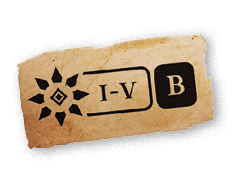
All vampires struggle with the inner hunger that calls for ever more blood. Only a consistent moral code –no matter how perverse – can keep this monster in check as the decades flow.
each player’s clan morality token onto the start position (-3), flipped according to their clan leader’s
 /
/
 .
.
When
 /
/
 activated, compare with player’s clan morality token.
activated, compare with player’s clan morality token.
1 space on the clan morality track.
clan morality token.
1 space on the clan morality track and draw 1 clan scheme.
Nothing happens if a clan morality token would be moved up from the highest space or down from the lowest space.
Player in highest position the 1st player marker.
X VP
to clan morality token position
If players are tied for the highest position, the first player marker does not move.
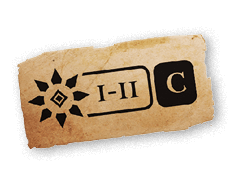
Europe churns with turmoil as rival courts vie to control the continent. Vampiric aristocrats trade estates and feeding
grounds in an age of excess. But eventually one faction will rise – and they will remember their friends.
7 ankhs onto each
 /
/
 /
/
 /
/
 home court.
home court.
When
 /
/
 /
/
 /
/
 activated, ankh of that faction to any adjacent court not controlled by a rival faction (i.e. not containing at least one ankh of another faction).
activated, ankh of that faction to any adjacent court not controlled by a rival faction (i.e. not containing at least one ankh of another faction).
Ankhs may not be moved back into any home court.
 vampires may activate any attribute, and score 1 VP at the end of the game.
vampires may activate any attribute, and score 1 VP at the end of the game.
The faction controlling the most courts the winning attribute.
Tied victories are possible.
The central space counts as two courts.
2 VP
per vampire of winning attribute
In the case of a tied victory, each vampire of a tied attribute scores 2 VP.
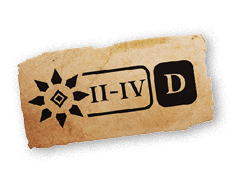
Tactless carnage between the clans has awakened a group of fanatics within the mortal church. Even these robed fools are bound to stumble across an impetuous vampire eventually. However, if this hunt cannot be stopped, perhaps it can be directed.
1 clan politics token on each
 /
/
 /
/
 /
/
 vaticanum space.
vaticanum space.
When
 /
/
 activated, clan politics token in matching
activated, clan politics token in matching
 /
/
 /
/
 /
/
 column to judices, if not there already. Then flip the clan politics token to match attribute.
column to judices, if not there already. Then flip the clan politics token to match attribute.
When all Judices places are filled, the vampire(s) with most
 is . If target’s suspicion (
is . If target’s suspicion (
 + matching clan politics tokens) is , place them into torpor. Otherwise target 1
+ matching clan politics tokens) is , place them into torpor. Otherwise target 1
 .
.
all tokens back to Vaticanum.
Vampires in cannot be targets of the inquisition. Ignore their infamy when determining targets.
Attribute with fewer face-up clan politics tokens . If both have 2 face-up, neither wins.
1 VP
per vampire of winning attribute
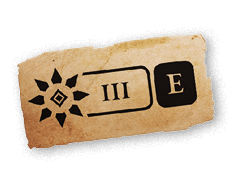
A call to rebellion echoes through Europe. The downtrodden and younger kindred have long been sacrificed to inquisitors or undead rivals, all for the advancement of their elders. Now they rise to overturn the established order and set the night aflame.
4 ankhs onto each
 /
/
 /
/
 /
/
 city.
city.
When
 /
/
 /
/
 /
/
 activated, take ankh from matching city and on activating vampire or by placing in the fire.
activated, take ankh from matching city and on activating vampire or by placing in the fire.
If the 3rd ankh from a city is burned, the 4th ankh.
Once an Ankh is placed on the fire space, it cannot be returned to the city. Ankhs on fire space do not return to the city during respite step.
 vampires may activate any attribute.
vampires may activate any attribute.
When removed from a city and placed, each vampire with matching ankh gains 1
 . all matching ankhs from vampires to city.
. all matching ankhs from vampires to city.
When vampire with ankh , place ankh in fire.
Cities with 1+ ankhs remain standing.
All matching attributes score.
X VP
per vampire of , where X = number of .
Each  vampire scores 1 VP at the end of the game.
vampire scores 1 VP at the end of the game.
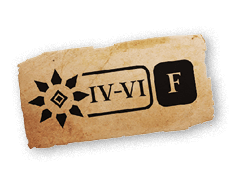
As the living world advances, kindred grudgingly retreat further into the night. Secrecy and obscurity become marks of honor and respect, while those who lapse are quickly punished for their complacency. The danger of a single curious mortal has become too great to ignore.
4 Investigator tokens on investigator space, and 3 ankhs on each
 /
/
 /
/
 /
/
 final space.
final space.
When
 /
/
 /
/
 /
/
 activated, an investigator 1 space on the matching track.
activated, an investigator 1 space on the matching track.
 vampires may activate any attribute – but the Investigator is advanced 2 spaces rather than 1.
vampires may activate any attribute – but the Investigator is advanced 2 spaces rather than 1.
When investigator reaches end space, ankh on activating vampire. the investigator.
2
 when placing vampire with ankh into torpor. ankh to battleground.
when placing vampire with ankh into torpor. ankh to battleground.
Advance any investigator 2 spaces when  activated.
activated.
All attributes score.
X VP
per vampire where X = ankhs on matching final space.
Each  vampire scores 1 VP at the end of the game.
vampire scores 1 VP at the end of the game.
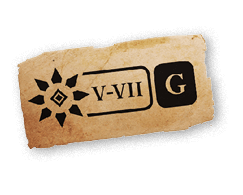
With the inquisition receding as a threat – derided by mortals now veiled in ignorance – a kind of stability emerges in each city. Several key titles have developed to bring order to the night, none more important than Prince. But uneasy lies the head that wears a crown …
5 clan politics token outside city walls, court title tokens on , and timer token above harpy space.
When
 /
/
 activated, a clan politics token inside city walls, and flip to match attribute.
activated, a clan politics token inside city walls, and flip to match attribute.
When all clan politics tokens are inside city walls, either
 /
/
 are in favor face-up tokens. The vampire in favor with most
are in favor face-up tokens. The vampire in favor with most
 (and no court title) the new title. clan politics tokens and move timer to next title.
(and no court title) the new title. clan politics tokens and move timer to next title.
their court title when placing any vampire with a title into torpor.
In the case of ties the title is not received by any vampire. Reset clan politics tokens and move timer to next title.
Vampires in torpor, as well as those already holding a court title, cannot gain titles. Ignore their power when holding votes.
Prince's
 /
/
 determines winning attribute.
determines winning attribute.
2 VP
per vampire of , and per in your bloodline
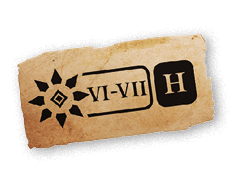
The world changes faster with each year, a dizzying crescendo of mortal ‘progress’ that risks leaving behind the unwary kindred. It is no longer wise to ignore the passing fancies of humanity. Keeping up with the kaleidoscope of history means one thing: change.
each player’s clan morality token onto the start position (8), flipped according to their clan leader’s
 /
/
 .
.
When
 /
/
 activated, compare with player’s clan morality token.
activated, compare with player’s clan morality token.
1 space on the track and draw 1 clan scheme.
clan morality token.
Nothing happens if a clan morality token would be moved up from the highest space or down from the lowest space.
Player in lowest position the 1st player marker.
X VP
to clan morality token position
If players are tied for the lowest position, the first player marker does not move.
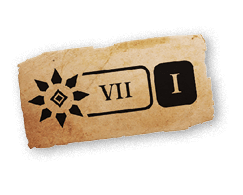
After centuries of simmering tension, violence once again explodes among powerful kindred factions. Coteries travel the globe in a nocturnal game of cat and mouse that risks destroying the Masquerade forever. Vampires don’t grow old by starting battles, but this time you must.
all numbered Sabbat Wars tokens face down on matching home spaces.
1 random Camarilla and 1 random Sabbat token on each region of the battleground.
Randomly , according to the number of players:
2 players: Camarilla / Sabbat
3 players: Camarilla / Sabbat / Anarch
4 players: Camarilla / Camarilla / Sabbat / Sabbat
When
 /
/
 /
/
 /
/
 activated, carry out the corresponding action:
activated, carry out the corresponding action:
Warlike
 : a token in matching region.
: a token in matching region.
Wealthy
 : token in matching region.
: token in matching region.
Clandestine
 : a token in matching region.
: a token in matching region.
Scholarly
 : a token from matching region to any other.
: a token from matching region to any other.
Each map space can only hold one token. If there is no space for a token to be added to a region, return it to the supply.
Reveal all tokens and to determine whether Camarilla or Sabbat control each region. Camarilla / Sabbat win by controlling 3+ regions. Otherwise Anarchs win.
9 VP
for player(s) of
winning allegiance
All three battlegrounds are always modified whenever a vampire is activated. The player may not choose to skip any of them (even if it hurts their position).
Each effect is carried out whenever a vampire's abilities are triggered. The player may not choose to skip any of them (even if it hurts their position).
No. Scheme effects and triggered abilities are always resolved from top to bottom.
Whenever an effect removes one or more characters from the queue, it is immediately refreshed. Note: if an effect indicates to remove multiple characters from the queue, these characters are all removed at once, and only then is the queue refreshed.
No. To sacrifice, the immediate childe of the targeted vampire must be placed into torpor.
Normally only a single scheme may be played per turn. However, the game effects "play an additonal scheme" allow additional schemes to be played in a single turn.
"Activate" means modify all three battlegrounds according to the vampire's attributes. "Trigger abilities" means carry out the special effects written on the card (if any) from top to bottom. Although both occur when a vampire is recruited into a bloodline, the two effects are distinct. For example: if a game effect activates a vampire, it does not also trigger their abilities (and vice versa).
No. Vampires in torpor are not considered part of the player's bloodline, and do not count when claiming missions.
No. The term 'any' always refers to 'any one' vampire. By way of contrast, the term 'each' always refers to all vampires that meet the criteria.
No. Boons can only be moved to another player's bloodline when carrying out a scheme, and the additional vampire(s) must be necessary to carry out the scheme.
It almost never matters in which order the battlegrounds are resolved. However, for the sake of the rare edge cases, and to make sure players don't accidentally skip a battleground, we encourage them to resolve in order from
 /
/
 to
to
 /
/
 to
to
 /
/
 /
/
 /
/
 .
.
All battleground effects are always carried out in full after each activation. Example battleground effects are Decisive Victory (Clans High and Low) or Trial (The Inquisition).
Immediately shuffle the discarded characters into a new deck. Use this new character deck as normal. If a player is using Embrace the Chaos (the Malkavian special ability) they continue seeking the declared attribute from the top of this deck as normal.
No. Exhaustion remain in play unless removed via another game effect (unexhaust or rejuvenate).
A bonded vampire may not be recruited into any other clan. For instance: a Ventrue vampire with the bonded ability can only be recruited into the Ventrue bloodline in future games.
If the player order becomes significant during the aftermath phase (for example, due to the scarcity of ability stickers) player order is determined in favor of the player who claimed fewer missions.
The number of stickers available to each clan has deliberately been kept low, in order to prevent any clan from becoming dominant. If a sticker must be applied but none remain for this clan, a Thin Blood sticker must be applied instead. Note: a Thin Blood sticker can be applied at any time a clan sticker would be applied. A player may do this for thematic reasons ("This character doesn't feel like a Gangrel...") or for strategic reasons ("I want want to keep Gangrel stickers for later in the chronicle").
This is extremely unlikely to happen. However, in this case, apply a sticker from any other clan.
Unlocked clan leaders always return to the haven of the player that unlocked them. It is not possible for another player to use this clan leader. However, any unlocked clan schemes remain unlocked for the rest of the chronicle.
No. For this reason, the clan leader cannot be selected to place into torpor.
We recommend flipping the marker to show which attribute is currently winning. However, when the token is in the neutral space, it doesn't matter which side is flipped up.
No.
 /
/
 is activated, but that archetype's token is already in judices? Is the token flipped (if necessary) to match the activating vampire's
is activated, but that archetype's token is already in judices? Is the token flipped (if necessary) to match the activating vampire's
 /
/
 ?
?Yes. The associated token remains in judices, but is flipped if necessary to match.
 , or just 1?
, or just 1?The vampire only gains 1
 .
.
No, it is never possible to recruit more characters into your bloodline than any other player. If a scheme allows a player to recruit a character, this must be carried out instead of their normal recruit phase.
Embrace the Chaos triggers a full recruit phase, including activating the new vampire and triggering their abilities. The remainder of the scheme is only carried out after these steps.
No. The bonded ability would take precedence. In this case, discard the character and continue searching for the named attribute.
The new vampire remains an enemy to the Brujah.
All ancillae taken using a craft monstrosity scheme are returned to the character deck, and may not be retained.
Each expansion includes a rules card explaining the new component types, and how they are used in the chronicle. Each card features an ID number that is used to place the card correctly within the chronicle deck. These cards can either be added to the chronicle deck when first beginning the campaign, or you can check each box after each game to see which components should now be revealed.
Yes. You can check the card ID numbers in relation to the chronicle deck, in order to see which cards should be revealed in each aftermath phases. The boardgamegeek user ahkaiser has provided a handy breakdown at this link (spoiler alert).
No. Absolutely not!
The chapter resolution cards each show an additional asset. The victor of this game takes the card itself, which can be played at any time as a regular asset.
Modify corresponding battleground. When activating a vampire, modify all three battlegrounds.
Any vampire with one or more special abilities.
The activating player chooses any other player and applies the indicated effect.
Colors indicating a character’s qualities in three categories: class (
 /
/
 ), temperament (
), temperament (
 /
/
 ), and geography (
), and geography (
 /
/
 /
/
 /
/
 ). Also, the symbol indicating a character’s archetype (
). Also, the symbol indicating a character’s archetype (
 /
/
 /
/
 /
/
 ).
).
Each player’s collection of recruited vampires, branching down from (and including) their clan leader. This excludes vampires in torpor unless explicitly stated otherwise.
Apart from the clan leader, every vampire in a player’s bloodline is the childe of their sire - the vampire directly above them. It is possible for a vampire to be both a childe and a sire.
Boons can be used to help satisfy the archetype requirements of any scheme.
Vampire at the top of each player’s bloodline.
The vampire selected to carry out a clan or battleground scheme. “Gain” effects always refer to the coterie leader.
The coterie leader plus all their direct childer.
An exhausted vampire cannot be selected as the coterie leader when playing a scheme.
Definition
Any vampire in a player’s bloodline with no childer.
Remove both exhaustion and torpor tokens from the selected vampire.
Place clan marker token on any unreserved character in the queue.
Every vampire in a player’s bloodline (including the clan leader) is a sire if they have a vampire directly beneath them (childe). It is possible for a vampire to be both a sire and a childe.
A vampire in torpor is effectively removed from the player’s bloodline. See Key Terms for more information.
Carry out the full effect of each of the triggered vampire’s abilities before moving to the next (top to bottom).
Great hovering! Or tapping. You are the sire of tooltips.